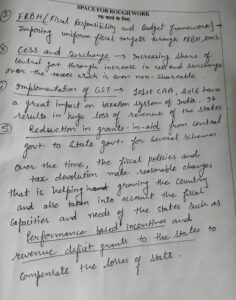The Indian Constitution, adopted on January 26, 1950, is one of the most comprehensive and lengthy constitutions in the world. Here are some of its key features: Lengthy and Detailed: The Indian Constitution is one of the longest written constitutions of any sovereign country, containing 395 articleRead more
The Indian Constitution, adopted on January 26, 1950, is one of the most comprehensive and lengthy constitutions in the world. Here are some of its key features:
- Lengthy and Detailed: The Indian Constitution is one of the longest written constitutions of any sovereign country, containing 395 articles and 12 schedules.
- Federal System with Unitary Bias: India follows a federal system where power is divided between the central government and the states. However, during emergencies, the Constitution provides for a unitary form of government.
- Parliamentary Democracy: India has a parliamentary form of government where the President is the head of state, and the Prime Minister is the head of government. The Council of Ministers is responsible to the Parliament.
- Fundamental Rights: The Constitution guarantees several fundamental rights to its citizens, including right to equality, right to freedom, right against exploitation, right to freedom of religion, cultural and educational rights, and right to constitutional remedies (Article 12 to 35).
- Directive Principles of State Policy: These are guidelines for the government to establish a just society in which the welfare of the people is the primary concern. Though not enforceable by courts, they are fundamental in the governance of the country (Article 36 to 51).
- Independent Judiciary: The Constitution establishes an independent judiciary headed by the Supreme Court. It ensures the protection of fundamental rights and acts as the guardian of the Constitution.
- Universal Adult Franchise: One of the most notable features is the provision of universal adult suffrage, giving every adult citizen the right to vote without any discrimination.
- Secularism: India is a secular state, ensuring equal treatment of all religions by the state. The Constitution mandates a separation of religion from the state.



The Preamble of the Indian Constitution acts as a guiding light, reflecting the vision and aspirations of its framers. It encapsulates the fundamental values and principles that the makers intended to embed in the Constitution. 1. Sovereignty: - The term "Sovereign" in the Preamble indicates theRead more
The Preamble of the Indian Constitution acts as a guiding light, reflecting the vision and aspirations of its framers. It encapsulates the fundamental values and principles that the makers intended to embed in the Constitution.
1. Sovereignty:
– The term “Sovereign” in the Preamble indicates the complete autonomy and independence of India, free from any external control.
– This reflects the makers’ determination for self-governance and national integrity.
2. Socialism:
– The word “Socialist” signifies a commitment to social equity and the elimination of inequality.
– It mirrors the framers’ intent to create a society where wealth and resources are distributed more equitably.
3. Secularism:
– “Secular” ensures that the state treats all religions equally without favoring any.
– This underscores the makers’ vision of religious freedom and harmony in a diverse country.
4. Democracy:
– The term “Democratic” highlights the commitment to a government by the people, for the people, and of the people.
– It reflects the framers’ belief in popular sovereignty and participatory governance.
5. Justice, Liberty, Equality, and Fraternity:
– These ideals are fundamental to the Preamble and reflect the core objectives of the Constitution.
– They signify the framers’ dedication to ensuring social, economic, and political justice, individual freedoms, equality before the law, and a sense of brotherhood.
The Preamble is a succinct reflection of the philosophical and moral vision of the Constitution’s makers.It serves as the soul of the Constitution, guiding its interpretation and implementation to achieve a just and equitable society.
See less